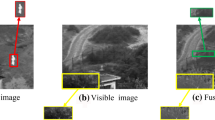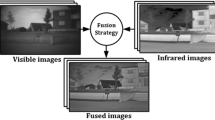Abstract
Deep learning-based separation representation methods have achieved promising performance in image fusion tasks. This is attributed to the fact that the network architecture plays a very important role in the decoupling process. However, building a superior fusion network based on decoupling tasks is difficult in general. Most of the current network constructions for separated representations are still black-boxed design. To overcome this problem, it is proposed to implement decoupled task based on traditional optimization decomposition method and establish a link between the optimal solution and network architecture to construct interpretable separated representation network. In this paper, we propose a deep learning-based learnable joint sparse low-rank separation representation method for multi-source image fusion (LJSLRnet). It avoids blind empirical network design by transforming the optimization problem. Specifically, we propose a learn-able joint sparse low rank model (LJSLR) and construct a LJSLR-based decou-pling module. The LJSLR model is designed as an iterative optimization problem based on matrix multiplication, and then the learned convolutional sparse coding (LCSC) is utilized to convert matrix multiplication into convolutional operation, which is the core of constructing LJSLR-based decoupling module. Next, the it-erative process of optimization is replaced by feedforward network based on iterative threshold shrinkage. To enhance the decoupling ability and robustness of the network, the low-rank sparse loss function and cross-reconstruction loss function are developed. Compared with the existing methods, the experiments verify the effectiveness of the proposed method.
Access this chapter
Tax calculation will be finalised at checkout
Purchases are for personal use only
Similar content being viewed by others
References
Zhang, Y., Liu, Y., Sun, P., Yan, H., Zhao, X., Zhang, L.: IFCNN: a general image fusion framework based on convolutional neural network. Inf. Fusion 54, 99–118 (2020)
Ma, J., Tang, L., Xu, M., Zhang, H., Xiao, G.: Stdfusionnet: an infrared and visible image fusion network based on salient target detection. IEEE Trans. Instrum. Meas. 70, 1–13 (2021)
Xu, H., Ma, J., Le, Z., Jiang, J., Guo, X.: Fusiondn: a unified densely connected network for image fusion. In: Proceedings of the AAAI Conference on Artificial Intelligence, vol. 34, pp. 12484–12491 (2020)
Ma, J., Xu, H., Jiang, J., Mei, X., Zhang, X.-P.: DDcGAN: a dual-discriminator conditional generative adversarial network for multi-resolution image fusion. IEEE Trans. Image Process. 29, 4980–4995 (2020)
Luo, X., Wang, A., Zhang, Z., Xiang, X., Wu, X.-J.: Latraivf: an infrared and visible image fusion method based on latent regression and adversarial training. IEEE Trans. Instrum. Meas. 70, 1–16 (2021)
Li, H., Wu, X.-J., Durrani, T.: Nestfuse: an infrared and visible image fusion architecture based on nest connection and spatial/channel attention models. IEEE Trans. Instrum. Meas. 69(12), 9645–9656 (2020)
Luo, X., Gao, Y., Wang, A., Zhang, Z., Wu, X.-J.: IFSepR: a general framework for image fusion based on separate representation learning. IEEE Trans. Multimedia 25, 608–623 (2021)
Deng, X., Dragotti, P.L.: Deep convolutional neural network for multi-modal image restoration and fusion. IEEE Trans. Pattern Anal. Mach. Intell. 43(10), 3333–3348 (2020)
Li, H., Xu, T., Wu, X.-J., Lu, J., Kittler, J.: LRRNet: a novel representation learning guided fusion network for infrared and visible images. IEEE Trans. Pattern Anal. Mach. Intell. 45(9), 11040–11052 (2023)
Sreter, H., Giryes, R.: Learned convolutional sparse coding. In: 2018 IEEE International Conference on Acoustics, Speech and Signal Processing (ICASSP), pp. 2191–2195. IEEE (2018)
Daubechies, I., Defrise, M., De Mol, C.: An iterative thresholding algorithm for linear inverse problems with a sparsity constraint. Commun. Pure Appl. Math. J. Issued Courant Inst. Math. Sci. 57(11), 1413–1457 (2004)
Gregor, K., LeCun, Y.: Learning fast approximations of sparse coding. In: Proceedings of the 27th International Conference on International Conference on Machine Learning, pp. 399–406 (2010)
Tang, L., Yuan, J., Zhang, H., Jiang, X., Ma, J.: Piafusion: a progressive infrared and visible image fusion network based on illumination aware. Inf. Fusion 83, 79–92 (2022)
Ma, J., Chen, C., Li, C., Huang, J.: Infrared and visible image fusion via gradient transfer and total variation minimization. Inf. Fusion 31, 100–109 (2016)
Li, H., Wu, X.-J., Kittler, J.: RFN-nest: an end-to-end residual fusion network for infrared and visible images. Inf. Fusion 73, 72–86 (2021)
Zhao, Z., et al.: Cddfuse: correlation-driven dual-branch feature decomposition for multimodality image fusion. In: Proceedings of the IEEE/CVF Conference on Computer Vision and Pattern Recognition, pp. 5906–5916 (2023)
Ma, J., Yu, W., Liang, P., Li, C., Jiang, J.: Fusiongan: a generative adversarial network for infrared and visible image fusion. Inf. fusion 48, 11–26 (2019)
Tang, L., Yuan, J., Ma, J.: Image fusion in the loop of high-level vision tasks: a semantic-aware real-time infrared and visible image fusion network. Inf. Fusion 82, 28–42 (2022)
Zhang, H., Xu, H., Xiao, Y., Guo, X., Ma, J.: Rethinking the image fusion: a fast unified image fusion network based on proportional maintenance of gradient and intensity. In: Proceedings of the AAAI Conference on Artificial Intelligence, vol. 34, pp. 12797–12804 (2020)
Xu, H., Ma, J., Jiang, J., Guo, X., Ling, H.: U2fusion: a unified unsupervised image fusion network. IEEE Trans. Pattern Anal. Mach. Intell. 44(1), 502–518 (2020)
Liu, J., et al.: Multi-interactive feature learning and a full-time multi-modality benchmark for image fusion and segmentation. In: Proceedings of the IEEE/CVF International Conference on Computer Vision, pp. 8115–8124 (2023)
Cheng, C., Xu, T., Wu, X.-J.: Mufusion: a general unsupervised image fusion network based on memory unit. Inf. Fusion 92, 80–92 (2023)
Ma, J., Tang, L., Fan, F., Huang, J., Mei, X., Ma, Y.: Swinfusion: cross-domain long-range learning for general image fusion via swin transformer. IEEE/CAA J. Automatica Sinica 9(7), 1200–1217 (2022)
Zhang, H., Ma, J.: SDNet: a versatile squeeze-and-decomposition network for realtime image fusion. Int. J. Comput. Vision 129(10), 2761–2785 (2021)
Maes, F., Collignon, A., Vandermeulen, D., Marchal, G., Suetens, P.: Multimodality image registration by maximization of mutual information. IEEE Trans. Med. Imaging 16(2), 187–198 (1997)
Sheikh, H.R., Bovik, A.C.: Image information and visual quality. IEEE Trans. Image Process. 15(2), 430–444 (2006)
Song, H., Yu, S., Song, L., Yang, X.: Fusion of multispectral and panchromatic satellite images based on contourlet transform and local average gradient. Opt. Eng. 46(2), 020502–020502 (2007)
Issa, N.P., Trepel, C., Stryker, M.P.: Spatial frequency maps in cat visual cortex. J. Neurosci. 20(22), 8504–8514 (2000)
Xydeas, C.S., Petrovic, V., et al.: Objective image fusion performance measure. Electron. Lett. 36(4), 308–309 (2000)
Haghighat, M.B.A., Aghagolzadeh, A., Seyedarabi, H.: A non-reference image fusion metric based on mutual information of image features. Comput. Electr. Eng. 37(5), 744–756 (2011)
TNO image fusion dataset. figshare (2014). https://doi.org/10.6084/m9.figshare.1008029.v2
Author information
Authors and Affiliations
Corresponding author
Editor information
Editors and Affiliations
Rights and permissions
Copyright information
© 2025 The Author(s), under exclusive license to Springer Nature Switzerland AG
About this paper
Cite this paper
Song, W., Huang, N., Luo, X., Zhang, Z., Xu, T., Wu, XJ. (2025). Infrared and Visible Image Fusion Method Based on Learnable Joint Sparse Low-Rank Decomposition. In: Antonacopoulos, A., Chaudhuri, S., Chellappa, R., Liu, CL., Bhattacharya, S., Pal, U. (eds) Pattern Recognition. ICPR 2024. Lecture Notes in Computer Science, vol 15305. Springer, Cham. https://doi.org/10.1007/978-3-031-78169-8_5
Download citation
DOI: https://doi.org/10.1007/978-3-031-78169-8_5
Published:
Publisher Name: Springer, Cham
Print ISBN: 978-3-031-78168-1
Online ISBN: 978-3-031-78169-8
eBook Packages: Computer ScienceComputer Science (R0)





